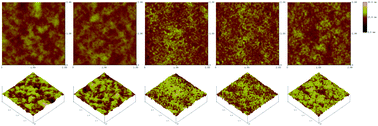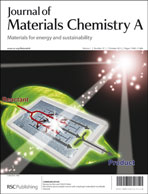A new quaternized ammonium polyfluorene polyelectrolyte poly[3,3′-(2-(3-hexyl-5-(7-(4-hexyl-5-methylthiophen-2-yl)benzo[c][1,2,5]thiadiazol-4-yl)thiophen-2-yl)-7-methyl-9H-fluorene-9,9-diyl)bis(N,N-dimethylpropan-1-amine)]dibromide (PFBTBr) is applied as the cathode interfacial layer of a polymer solar cell based on poly(3-hexylthiophene) (P3HT) and [6,6]-phenyl C61-butyric acid methyl ester (PC61BM). Electrostatic force microscopy (EFM) measurements of PFBTBr layers demonstrate the formation of the interfacial dipole between the active layer and the cathode by inserting a PFBTBr interfacial layer. Atomic force microscopy (AFM) measurements of PFBTBr layers with varied concentrations show that the morphology of the PFBTBr layer plays a direct, important role in the contact quality between the active layer and the PFBTBr interfacial layer, which can strongly affect the performance of devices. X-ray photoelectron spectroscopy measurements (XPS) indicate that PFBTBr may serve as a protective agent for the active layer against Al-induced degradation, since it prevents hot aluminum atoms from diffusing into the active layer. The power conversion efficiency (PCE) of the PSCs with the PFBTBr layer reaches 3.9% under the illumination of AM 1.5G, 100 mW cm−2, which is 1.6 times higher in comparison with that (2.4%) of the device without the PFBTBr layer. The significant increase in efficiency and easy utilization indicate that this interfacial material has promising and practical application prospects.

You have access to this article
 Please wait while we load your content...
Something went wrong. Try again?
Please wait while we load your content...
Something went wrong. Try again?


 Please wait while we load your content...
Please wait while we load your content...